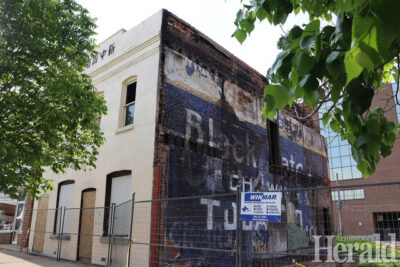Two week reprieve given for demolition approval of historic building
By Al Beeber - Lethbridge Herald on May 31, 2023.
 Herald photo by Al Beeber
Members of the Chinese community have been given two weeks to meet with the owner of the Manie Opera Society building to find ways of salvaging the resource.
Herald photo by Al Beeber
Members of the Chinese community have been given two weeks to meet with the owner of the Manie Opera Society building to find ways of salvaging the resource.LETHBRIDGE HERALDabeeber@lethbridgeherald.com
Members of the Chinese community say they were shocked to hear about a proposal coming before council on Tuesday to approve demolition of an historic downtown building.
And they have been given two weeks to meet with the owner of the Manie Opera Society building to find ways of saving part of Lethbridge’s history.
That building in the city’s Chinatown was built in 1907, the same year riots broke out against members of the Chinese community.
The building was heavily damaged in January because of a fire that broke out at the adjacent Bow On Tong building. That building was subsequently demolished.
On Tuesday, council was asked to approve an administration recommendation to allow the owner of the Manie Opera Society building at 318 2 Ave. S. demolish it.
The request, made by senior community planner Ross Kilgour, was made on behalf of the owner of the property which is designated a Municipal Historic Resource.
Council heard the City could face legal liability if it didn’t approve the demolition request should any harm be done and the fact the matter was addressed publicly, made that liability of particular concern.
But after hearing from the members of the Chinese community council voted by a 6-3 vote to give them two weeks to meet with the owner to find ways of salvaging some elements of the building. The motion calls for council to direct administration to issue a Heritage Intervention Approval effective on June 13 for the demolition and backfilling of the structure.
Council heard the building was heavily damaged during the Bow On Tong building which is owned by the same person and there are safety concerns with it not being torn down.
Councillor Belinda Crowson made an impassioned plea to save the building citing the Oliver Building which was saved from the wrecker’s ball and been restored.
She said the possibility exists to do the same with the Manie Opera Society Building.
She said 116 years ago the Chinese community built the structure and now council has a chance to save it. She said the community deserves to have a conversation on its future.
A submission from Kilgour states a fire on Jan. 31 at the adjacent Bow On Tong building necessitated its demolition.
That same fire caused damage to the Manie Opera Society building because of both the blaze and water. A structural engineer, says Kilgour’s submission, recommends demolishing it due to the damage and the property owner’s lack of financial ability to stabilize it.
Because it is a Municipal Heritage Resource, the building can’t be torn down without written approval by city council or a person appointed by council to provide that approval.
Approval also must come from the Alberta government because the building is also listed as a Provincial Historic Resource, a designation recently granted on April 27.
The demolition is not supported by the Historic Places Advisory Committee which would prefer it salvaged if there is a remote chance of that possibility.
In his submission Kilgour stated HPAC recently passed a resolution stating it’s “not prepared to recommend that city council direct administration to issue an intervention approval for demolition at this time.”
However, the City’s department of Planning & Design is recommending council issue that intervention approval due to safety concerns, the property owner’s financial constraints and to stay aligned “with the province’s decision to approve demolition and backfilling.”
Members of the Chinese community told media after the vote that two weeks isn’t much but it gives them a bit of optimism.
Ying Zheng, a spokesperson for the Chinese community and vice president of the southern Alberta Chinese Association as well as a board member of the Chinese Cultural Society, said “I think we are still in shock. We just got this news yesterday and we rushed here.
“We really didn’t have enough time to think about the pros and cons and how to proceed and how to face this whole issue. It’s just very sad. Ask anybody on the street, if it’s anyone older than 50 years old they all have fond memories of Bow On Tong.
“And they’re also very sad. One accurately expressed my feelings – I feel very helpless. And we all feel very helpless because we feel something is not done fairly and unfortunately it happened,” said Zheng, who has taught at the University of Lethbridge for 20 years.
“I also came out of the meeting with some optimism because I think we do have a forward looking, friendly council. Some of them are very caring about the history of Lethbridge” and its future, she said.
The building, said Zheng, has significance to not only the Chinese community but the entire city.
“We are losing Bow On Tong, I did some historical digging and I realized that building was built in 1907, just as councillor Crowson said that It was the time when they had the riot against Chinese people. And then now there’s some anti-Asian sentiment going around. and exactly the time they tried to demolish it again.”
She said several buildings are all together and reflects the segregation policy of their era.
“Now they’re disappearing and we’re losing our history. It feels like we’re losing our roots, she said.
“It’s not just the history of the Chinese, it’s the history of Lethbridge, it’s the history of Alberta.” The buildings were built by people who emigrated to Canada in the 1880s and 1890s and they “helped to build Lethbridge the way it is today,” Zheng said.
The Manie Opera Society Building was cited as having numerous character-defining elements when it was designated a Municipal Historic Resource.
They include according to the submission before council:
• The original materials: stucco on brick on the front facade.
• The flat roof with parapet.
• The pattern, style and construction of all wooden windows.
• The stone sills and arches above windows.
• The pattern, style, and construction of wooden door on the eastern side of the front facade.
• The minor cornice on second story.
• The original signage on parapet in Chinese characters (ghost signage).
It’s not known if any of those elements can be saved and restored.
Follow @albeebHerald on Twitter
42-41




